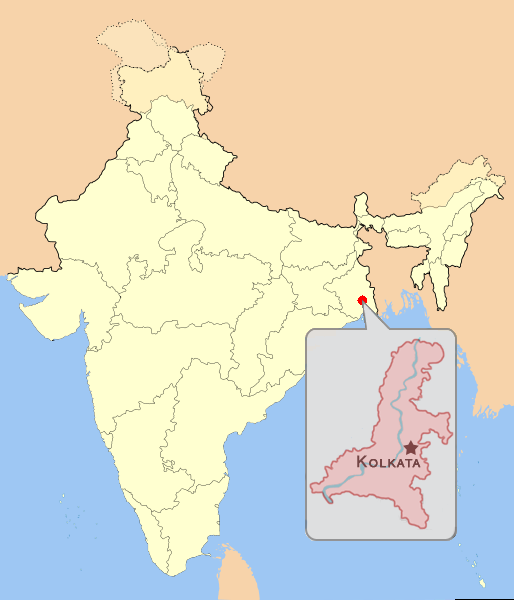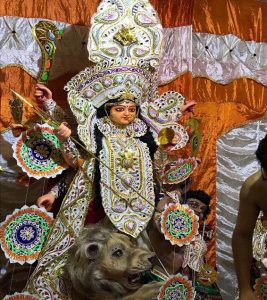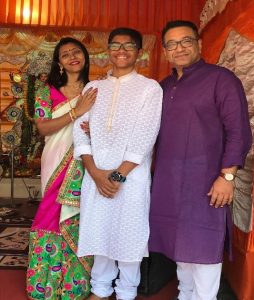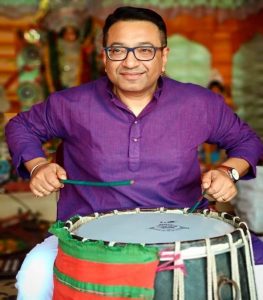
Customs and Cuisine of India
By Vinola V. Munyon
What’s in a Name?
It is often said that the states of India are akin to countries in Europe. So different are they in the languages spoken (each state in India has a different primary language), the type of food prepared and eaten, and the way of life/culture, that to extrapolate what might be considered Indian to a state within the country would not be just mildly misleading but grossly inaccurate. So, this month, we dine for the women and children of the city of Kolkata, where Her Future Coalition works with local partners to provide shelter, education and employment for rescued girls and women.
For Kolkata, the capital city of the State of West Bengal, behind its name is the story of a city attempting to shed its anglicized identity and reclaiming its precolonial identity, effecting a compromise of sorts with an amalgam of the two. Originally known as Kalikata, meaning “grounds of the goddess Kali” per one interpretation, the city rose to prominence when it was declared the capital of the British Raj. Rechristened Calcutta by the British, the city retained this name until 2001, long after the British had departed and India had gained independence. Interestingly, as an example perhaps of the dichotomy that is often a subtext in colonial cultures, even when the city was officially named and known as Calcutta, the locals referred to it as Kalikata when speaking in Bengali but as Calcutta when speaking in English. Also, despite the official change in name, some institutions in Kolkata continue, even today, to retain their anglicized name, the Calcutta University, The Calcutta Electric Supply Co. being but a few examples.
Among the city’s nicknames are “city of joy”, “city of furious, creative energy”, “city of palaces” and “gateway of Eastern India.”
The People
Befitting a city that is lauded as the literary and cultural capital of India, the Bengalis continue to patronize a way of life that promotes and indulges in the arts. While the demonym for one who lives/is from Kolkata is Kolkatan, the locals refer to themselves as Bengalis. Hinduism is the dominant religion, followed by Islam, Christianity, and Jainism. Sikhism and Buddhism are also practiced by a few. Kolkata was originally home to the only “Chinatown” in India, with a sizeable population of ethnic Chinese settled in the city. Kolkata was easily accessible by land from mainland China, and starting with Yang Tai Chow in 1778, an estimated 20,000 – 30,000 Chinese immigrants would migrate to Kolkata (then Calcutta). The birth of Indo-Chinese cuisine is traced to Tiretta Bazaar in Kolkata. Story goes that the immigrant Chinese set up Chinese eating houses for the immigrants and initially catered only to the Chinese. Noting the Indians’ interest in eating in their establishments however, they adapted their dishes to accommodate the Indian tastes by adding onions, ginger, garlic, chilies, and Indian spices to make a sauce for their dishes. This would become the ubiquitous “Schezwan sauce” that would become a fixture in the style of Indo-Chinese cuisine that came to be known as Hakka Chinese. Kolkata was also home to a Jewish community, that at the height of in-migration was abut 6,000 in number. The first Jewish settler in Kolkata, Shalom Aharon Obadiah Cohen, arrived in 1798 and was from present-day Syria. Today that number is estimated to be less that 100. Five synagogues remain in Kolkata, of which two are still active.
Bengali is the official state language and the one most widely spoken. English, Hindi, Urdu, and Sanskrit are also in use.

Durga Ma, the primary deity of Bengalis.
Credit: Mita Saha Singh
The Family Unit
The multigenerational joint family has been the traditional family unit and it continues to coexist in Kolkata with nuclear families, despite the shift to more women working outside the home. Some might even say, that is because of, and not in spite of, more women working outside the home. Recent data indicates that within urban areas there has been an increase in the multigenerational family structure, and some suggest that this is associated with the built-in child care and companionship that this structure affords. While a patriarchal society, Bengali women do enjoy a fair amount of independence within the family. The emphasis on education for children irrespective of gender is considered to be one potential reason, another being that the primary deity for Bengalis is Kali/Durga, a strong female seen as defender of good and avenger against evil.
Human Trafficking
Kolkatta is home to the largest red-light district in India, Sonagachi. Most of the women and children who work here are trafficked or born into the business. Children from poor rural regions of the country are brought to cities such as Kolkata with the promise of employment opportunities and sold instead into domestic slavery or to one of many red-light districts. Many more still are abducted and suffer the same fate. In 2016, West Bengal topped the list of states with the highest number of trafficked individuals.
The Food of Kolkata
The cuisine of Kolkata is almost as storied as its art and culture scene. “Bengalis live to eat” so goes a common adage which is embraced and celebrated by the Bengalis as a compliment. Bengali cuisine is a function of its traditional, agrarian lifestyle, it’s location in the Ganges delta with access to many freshwater sources, and the influences of the many cultures that ruled over the city or immigrated there (the Mughals, the British, French, Portuguese, and the Chinese, to name a few). The cuisine is dominated by vegetarian dishes, with rice and wheat being the staple starch. Lentils and legumes of many varieties are the primary protein. Fish is the animal-based protein of choice, be it freshwater, marine, or cultivated. While over 40 species of fish are consumed, Hilsa fish is a favorite and the mere mention of Hilsa fish evokes nostalgia in expat Bengalis. Among meat, the meat of goat, called mutton in India (not to be confused with meat of a mature sheep) is most commonly consumed. Bengali desserts are an especially famous part of Bengali cuisine and are made mostly of dairy and dairy products.
An aspect of Bengali cuisine that is unique among other cuisines in India is the multicourse style, with each course catering to a different taste. Also interesting is the use of all parts of a vegetable/protein. Little goes to waste. Stalks, peels, flowers, etc. of a vegetable are all put to use either in the same dish or in different dishes. The heavy emphasis on vegetarian food and the lack of food waste is rooted in a repressive and sexist practice from West Bengal’s history, that of “widow food.” Widows in Hindu culture in the Bengals were banished from the family home and lead a life of deprivation, akin to monks within a monastery. They were barred from wearing colorful garments (only a plain white sari), jewelry, or flowers and had to have their heads shorn. Also forbidden was meat and any ingredients deemed to cause “heat” (e.g., onion, garlic). Every scrap was to be utilized. From this rose the concept of “niramish” dishes, vegetarian dishes with few spices that utilized every part of the vegetable. The heads of fish, which tend to be discarded in some cuisines, are not just incorporated into the dish but are often the star of the dish. The flavor of dishes are complex, layered and savory or mildly sweet. Bengali cuisine is known for its inventive combination of spices such as the “panch phoron” (five spices), a mix of cumin, fennel, fenugreek, nigella seeds, and mustard seeds. Heat in dishes come from the addition of fresh green chilies. While whole mustard seeds are used in other cuisines in India, the use of ground mustard paste is uniquely Bengali. Mustard oil is the preferred cooking medium.
A typical breakfast is luchi (puffy fried unleavened bread) with alur torkari (sautéed potato in a tomato gravy), or kochuri (fried, puffy bread with a filling, typically mashed peas sautéed with spices) or porota (triangular or round homemade bread with or without stuffing).
Traditionally the course-wise lunch or dinner involved some of these courses served with rice: bitter greens (shukto), vegetables (shak), dal, animal protein (if being served), chutney, pappad (savory wafers), and desserts. Now, on a given day, lunch and dinner are typically rice (baath) or roti (tortilla like bread) as the starch. Accompanied by lentils (dal) with vegetables (sobji) or fish (machar jhol – fish curry) or meat (kosha mangsho – mutton curry). Machar Jhol is the quintessential Bengali meal and one that is consumed several times a week.
Special occasions are marked by more elaborate courses and involve dishes such as pulao, biriani (fragrant spiced rice cooked with mutton/fish/egg), kebabs etc.
Bengali desserts are a throwback to the Portuguese and Dutch influence, with cottage cheese as the main ingredient in some of Kolkata’s most famed desserts. Mishti Doi (sweet yogurt), Rosogolla (dumplings of cottage cheese soaked in syrup), Shondesh (cottage cheese and sugar confections that are flavored and include nuts/dried fruits), and Khir/Firni (rice pudding that is made with jaggery in the winter) are some of the more famous desserts.
Street food in Kolkatta has won acclaim as the best among the nation.
The Bengali Way of Life

Bengali family in traditional attire.
Credit: Mitu Saha Singh, pictured with her husband and son.
The Bengalis are known to be a contemplative, laidback, politically active and culturally rich group of people. “Chaul Aada Maari” is a common refrain. Loosely translated it means “come, let’s chat” and refers to the lively culture of free-style, informal but erudite conversations that can last sometimes for hours over copious cups of “cha” (chai, tea). Often compared to the oral culture that was prevalent in New York and Paris in the 50s, Adda still lives on in Kolkata. “Adda: Calcutta, Kolkata,” a 2011 documentary film, explores this riveting culture and won the Golden Palm Award at the Mexico International Film Festival 2012.
“Lyadh” is another concept that provides a glimpse into life and living in Kolkata. Akin to a siesta it is a practice of essentially lounging while sipping on refreshments with emphasis laid on having “nary a care in the world.”
The place of origin of five Nobel laureates and a long list of historians, poets, artists, philosophers, scientists, freedom fighters, reformers etc., Kolkata is home to national cultural and scientific institutions. This ethos of laying much emphasis on being cultured and intellectual filters into everyday life, with the people being generally more open to change while still being respectful of older traditions. For instance, on greeting an elder, the younger individual usually touches the elders’ feet as a sign of respect and receives the elders’ blessings.
Cotton is the preferred fabric. The traditional attire for women is a sari and for men, kurta pajamas. However, traditional attire is reserved for special occasions and salwar kameez or western wear is worn for daily wear. Marriage ceremonies are a multi-day celebration, typically lasting 3 days. Married women wear loha (an iron bangle dipped in gold), shakka pola (red and white bangles), and sindoor (prominent vermillion on the forehead) as visible symbols of being wed.

Surjit Singh plays the traditional drums on the occasion of Durga Puja
Credit: Mitu Saha Singh
Among the major festivals celebrated in Kolkata are: Durga puja, which lasts for 9 days and celebrates the goddess Durga, Pola boishakh, which is the Bengali new year celebration and occurs in April, and Dol, the festival of colors (also known as Holi in parts of India).
Unlike the rest of India where cricket is king, Bengalis love and worship their cricket “heroes” but football gets top billing.
In the Western world, Kolkata is known through its association with Mother Teresa, consequently, the images it evokes are of a city of squalor and poverty and one that needed rescuing. As much as they love and revere Mother Teresa, this association pains Bengalis because it misses the forest for the trees. Kolkata is so much more than that. It is a city steeped in artistic and intellectual fervor, bookstores, and high tea, some of the most famous food cultures in the word, and a populace that takes immense pride in being “Bong” (slang for Bengali).
Sources:
The primary source for this article was interviews with the following Bengali friends of the author:
- Mitu Saha Singh
- Soumita Roy Choudhuri
- Alpana Chand
https://www.cnn.com/travel/article/india-chinese-food-fusion/index.html
https://dbs.bh.org.il/place/calcutta
https://www.nytimes.com/2005/05/15/travel/tmagazine/the-chattering-masses.html?_r=0
View Recipes from India
India
